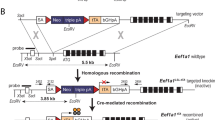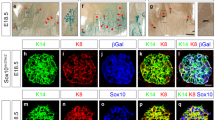Abstract
Wnt-10b is expressed during the formation of the mammary rudiment in mouse embryos and its expression continues through puberty when the mammary ductal pattern is established under control of ovarian steroids. Recently, viral activation of the Wnt-10b locus has linked its overexpression to mammary tumor formation, suggesting a role for Wnt-10b in patterning and growth-regulation of the mammary gland. To test this notion, we created lines of transgenic mice that express elevated levels of Wnt-10b under the control of the MMTV promoter/enhancer. Overexpression of this gene resulted in profound developmental alterations in the mammary gland, including expanded glandular development and the precocious appearance of alveoli in virgin females. Moreover, transgenic male mice also exhibited dramatic mammary development involving highly branched mammary ducts and gynecomastia. Aberrant expression of Wnt-10b in the mammary rudiments of males evidently bypasses the normal requirement for ovarian hormonal control in stimulating mammary ductal growth and the repressive effects of androgens. In addition to these developmental effects, transgenic mice of both sexes were highly susceptible to the development of mammary adenocarcinomas. Such tumors arose in a solitary manner indicating that Wnt-10b is a proto-oncogene which provides a necessary, but insufficient signal for oncogenesis. Relevant to this, there was no evidence of amplified expression of FGF mRNAs in these tumors though the Fgf's are a class of genes often implicated as collaborators in Wnt-mediated tumor formation. Indeed, co-expression of MMTV-Wnt-10b and MMTV-FGF-3/int-2 resulted in sterile offspring with highly disorganized mammary epithelium, demonstrating a potent interaction between their respective developmental pathways. These results suggest that Wnt-10b, or other Wnt genes expressed early in mammary development, play a role in regulating sexual dimorphism and show potent transforming activity when overexpressed.
This is a preview of subscription content, access via your institution
Access options
Subscribe to this journal
Receive 50 print issues and online access
$259.00 per year
only $5.18 per issue
Buy this article
- Purchase on Springer Link
- Instant access to full article PDF
Prices may be subject to local taxes which are calculated during checkout
Similar content being viewed by others
Author information
Authors and Affiliations
Rights and permissions
About this article
Cite this article
Lane, T., Leder, P. Wnt-10b directs hypermorphic development and transformation in mammary glands of male and female mice. Oncogene 15, 2133–2144 (1997). https://doi.org/10.1038/sj.onc.1201593
Received:
Revised:
Accepted:
Issue Date:
DOI: https://doi.org/10.1038/sj.onc.1201593
Keywords
This article is cited by
-
Elevated EDAR signalling promotes mammary gland tumourigenesis with squamous metaplasia
Oncogene (2022)
-
Gap Junctions and Wnt Signaling in the Mammary Gland: a Cross-Talk?
Journal of Mammary Gland Biology and Neoplasia (2019)
-
Dramatic dysbalancing of the Wnt pathway in breast cancers
Scientific Reports (2018)
-
The Terminal End Bud: the Little Engine that Could
Journal of Mammary Gland Biology and Neoplasia (2017)
-
Intronless WNT10B-short variant underlies new recurrent allele-specific rearrangement in acute myeloid leukaemia
Scientific Reports (2016)



